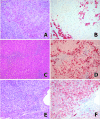Expression of K19 and K7 in dysplastic nodules and hepatocellular carcinoma
- PMID: 22844356
- PMCID: PMC3402733
- DOI: 10.3892/ol.2012.731
Expression of K19 and K7 in dysplastic nodules and hepatocellular carcinoma
Abstract
Hepatocellular carcinoma (HCC) is one of the most common types of malignant tumors characterized by a multistep process of tumor development. Nodular lesions that differ from the surrounding liver parenchyma and are characterized by cytological or structural atypia are termed dysplastic nodules (DNs). DNs are well-known precancerous HCC lesions. Expression of keratin (K) 19 and K7, molecular markers of hepatic progenitor cells and cholangiocytes, has been reported in certain HCCs. However, it remains unclear whether K19-positive HCC cells are derived from true hepatic progenitor cells or mature cells that have undergone a dedifferentiation or a transdifferentiation process. In total, 107 tissue sections (13 low-grade DNs, 15 high-grade DNs, 27 small HCCs and 52 large HCCs) from resected liver samples and 132 HCC tissue microarray (TMA) cores were subjected to immunohistochemical analysis for K19 and K7. Clinicopathological data of the HCC patients were evaluated. K19 expression was found in 0% of DNs, 19% of small HCCs (≤2 cm), 8% of large HCCs (>2 cm) and 8% of TMA samples. K7 expression was found in 14% of DNs, 41% of small HCCs, 15% of large HCCs and 6% of TMA samples. Among the five K19-positive small HCCs, four were distinctly nodular and one tumor was an infiltrative type. No vaguely nodular HCC was positive for K19. K19 expression was significantly associated with histological grade (P=0.023), serum α-fetoprotein level (P=0.001) and K7 expression (P=0.001) in HCC. K19 expression was an independent prognostic factor for overall survival in non-viral HCC patients (P=0.003). K19 expression is extremely rare in DNs and occurs in progressed small HCCs. Our results suggest that K19 expression may be an acquired feature of carcinoma cells during HCC progression in certain HCCs.
Figures


Similar articles
-
Expression of multidrug resistance-associated protein 1 in hepatocellular carcinoma is associated with a more aggressive tumour phenotype and may reflect a progenitor cell origin.Liver Int. 2008 Dec;28(10):1370-80. doi: 10.1111/j.1478-3231.2008.01889.x. Liver Int. 2008. PMID: 19055643
-
Clinicopathological study on cholangiolocellular carcinoma suggesting hepatic progenitor cell origin.Hepatology. 2008 May;47(5):1544-56. doi: 10.1002/hep.22238. Hepatology. 2008. PMID: 18393293
-
Heterogeneity of Epigenetic and Epithelial Mesenchymal Transition Marks in Hepatocellular Carcinoma with Keratin 19 Proficiency.Liver Cancer. 2019 Jul;8(4):239-254. doi: 10.1159/000490806. Epub 2018 Aug 21. Liver Cancer. 2019. PMID: 31602368 Free PMC article.
-
Early hepatocellular carcinoma and dysplastic nodules.Semin Liver Dis. 2005;25(2):133-42. doi: 10.1055/s-2005-871193. Semin Liver Dis. 2005. PMID: 15918142 Review.
-
Clinico-Radio-Pathological and Molecular Features of Hepatocellular Carcinomas with Keratin 19 Expression.Liver Cancer. 2020 Dec;9(6):663-681. doi: 10.1159/000510522. Epub 2020 Oct 23. Liver Cancer. 2020. PMID: 33442539 Free PMC article. Review.
Cited by
-
Analysis of clinicopathologic and imaging features of dual-phenotype hepatocellular carcinoma.Sci Rep. 2024 Feb 9;14(1):3314. doi: 10.1038/s41598-024-53831-5. Sci Rep. 2024. PMID: 38332165 Free PMC article.
-
The Recent Advances on Liver Cancer Stem Cells: Biomarkers, Separation, and Therapy.Anal Cell Pathol (Amst). 2017;2017:5108653. doi: 10.1155/2017/5108653. Epub 2017 Jul 27. Anal Cell Pathol (Amst). 2017. PMID: 28819584 Free PMC article. Review.
-
Identification of New Players in Hepatocarcinogenesis: Limits and Opportunities of Using Tissue Microarray (TMA).Microarrays (Basel). 2014 Apr 15;3(2):91-102. doi: 10.3390/microarrays3020091. Microarrays (Basel). 2014. PMID: 27600338 Free PMC article. Review.
-
Diagnostic value of expressions of cancer stem cell markers for adverse outcomes of hepatocellular carcinoma and their associations with prognosis: A Bayesian network meta‑analysis.Oncol Lett. 2024 Sep 6;28(5):536. doi: 10.3892/ol.2024.14669. eCollection 2024 Nov. Oncol Lett. 2024. PMID: 39290959 Free PMC article.
References
-
- Parkin DM, Bray F, Ferlay J, Pisani P. Global cancer statistics, 2002. CA Cancer J Clin. 2005;55:74–108. - PubMed
-
- Ferlay J, Shin HR, Bray F, Forman D, Mathers C, Parkin DM. Estimates of worldwide burden of cancer in 2008: GLOBOCAN 2008. Int J Cancer. 2010;127:2893–2917. - PubMed
-
- Park YN. Update on precursor and early lesions of hepatocellular carcinomas. Arch Pathol Lab Med. 2011;135:704–715. - PubMed
-
- Theise ND, Curado MP, Franceschi S, Hytiroglou P, Kudo M, Park YN, Sakamoto M, Torbenson M, Wee A. Hepatocellular carcinoma. In: Bosman FT, Carneiro F, Hruban RH, Theise ND, editors. WHO Classification Of Tumours Of The Digestive System. 4th edition. IARC Press; Lyon: 2010. pp. 205–216.
-
- Durnez A, Verslype C, Nevens F, Fevery J, Aerts R, Pirenne J, Lesaffre E, Libbrecht L, Desmet V, Roskams T. The clinicopathological and prognostic relevance of cytokeratin 7 and 19 expression in hepatocellular carcinoma. A possible progenitor cell origin. Histopathology. 2006;49:138–151. - PubMed
LinkOut - more resources
Full Text Sources
Research Materials
